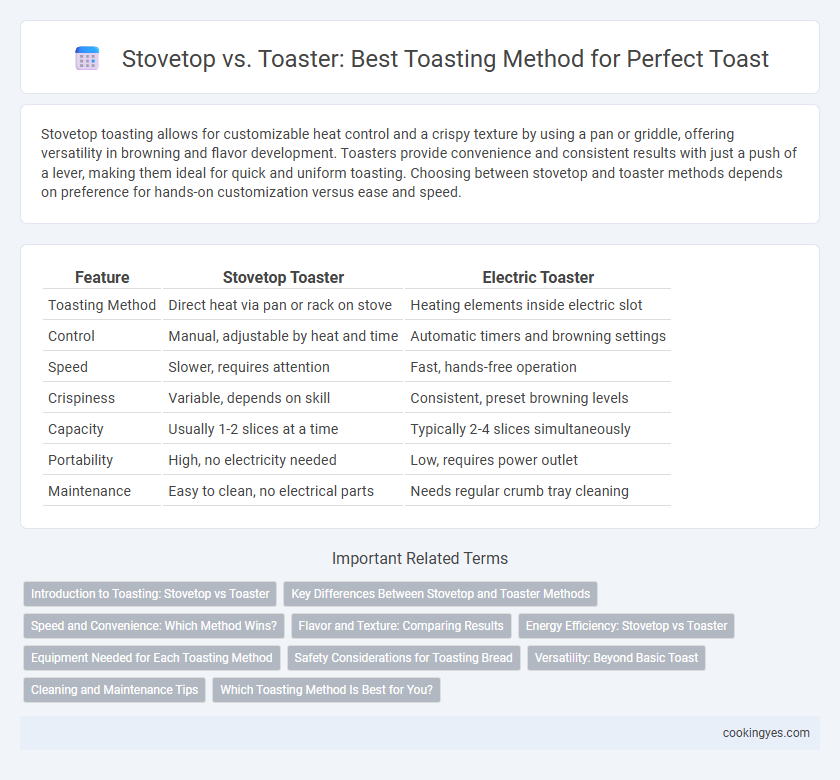Stovetop toasting allows for customizable heat control and a crispy texture by using a pan or griddle, offering versatility in browning and flavor development. Toasters provide convenience and consistent results with just a push of a lever, making them ideal for quick and uniform toasting. Choosing between stovetop and toaster methods depends on preference for hands-on customization versus ease and speed.
Table of Comparison
| Feature | Stovetop Toaster | Electric Toaster |
|---|---|---|
| Toasting Method | Direct heat via pan or rack on stove | Heating elements inside electric slot |
| Control | Manual, adjustable by heat and time | Automatic timers and browning settings |
| Speed | Slower, requires attention | Fast, hands-free operation |
| Crispiness | Variable, depends on skill | Consistent, preset browning levels |
| Capacity | Usually 1-2 slices at a time | Typically 2-4 slices simultaneously |
| Portability | High, no electricity needed | Low, requires power outlet |
| Maintenance | Easy to clean, no electrical parts | Needs regular crumb tray cleaning |
Introduction to Toasting: Stovetop vs Toaster
Toasting bread on a stovetop offers precise control over heat, enabling a customizable browning process often favored for artisanal or rustic textures. Toasters provide consistent, even toasting through automated heating elements and preset cycles, making them ideal for quick and uniform results. Choosing between stovetop and toaster methods depends on factors like desired texture, time efficiency, and equipment availability.
Key Differences Between Stovetop and Toaster Methods
Stovetop toasting involves direct heat control and allows for customizable browning intensity using a pan or griddle, whereas toaster methods offer consistent, fast, and automated browning through electric heating elements. Stovetop methods require manual attention and flipping for even toasting, while toasters provide uniform heat distribution with pre-set timing functions. The choice impacts texture, flavor development, and convenience, with stovetop enhancing crispness and char, and toasters optimizing speed and simplicity.
Speed and Convenience: Which Method Wins?
Stovetop toasting typically takes longer, requiring constant attention to avoid burning, whereas a toaster offers quick, consistent results with minimal effort. Toasters excel in speed, typically browning bread in 2-3 minutes, while stovetop methods vary based on heat control and pan type. The convenience of automatic toasting settings makes toasters the preferred choice for fast, hassle-free toast preparation.
Flavor and Texture: Comparing Results
Stovetop toasting imparts a richer, smoky flavor and allows precise control over browning, resulting in a crisp exterior with a tender interior. A toaster provides consistent, even toasting, producing a uniform golden texture but often lacks the depth of flavor achieved on a stovetop. Choosing between the two methods depends on the desired balance of artisanal flavor and convenience.
Energy Efficiency: Stovetop vs Toaster
Using a stovetop for toasting bread consumes more energy due to longer heating times and less controlled heat distribution compared to electric toasters. Toasters are designed for optimal energy efficiency with rapid heating elements that toast bread evenly in minutes, reducing overall electricity consumption. Energy Star-rated toasters can further enhance efficiency by minimizing power use during standby modes.
Equipment Needed for Each Toasting Method
Stovetop toasting requires a skillet or frying pan and sometimes a cover to ensure even heat distribution, offering manual control over browning. A toaster demands a dedicated electric appliance with slots designed for evenly toasting bread quickly and consistently. Both methods need basic kitchen equipment, but the stovetop offers versatility while the toaster provides convenience.
Safety Considerations for Toasting Bread
Using a toaster ensures regulated heat application and automatic shut-off features, significantly reducing the risk of burns or fires during bread toasting. Stovetop toasting demands constant attention to prevent overheating, charring, and potential fire hazards, especially if the bread is left unattended. For safety, choosing an electric toaster with built-in sensors and timers is recommended to minimize accidents and ensure consistent toasting results.
Versatility: Beyond Basic Toast
Stovetop toasting offers versatility by allowing users to toast a variety of foods like bread, bagels, and even sandwiches with precise control over browning and texture. Toasters excel in convenience and speed for standard sliced bread but lack the ability to handle thicker or irregularly shaped items. For recipes requiring melting cheese or achieving a crispy crust, stovetop toast methods provide greater flexibility beyond simple toasting.
Cleaning and Maintenance Tips
Stovetop toasting requires regular wiping of spills and occasional scrubbing of the pan to prevent residue buildup, while toaster maintenance involves emptying crumb trays frequently to avoid blockages and crumbs accumulation. Cleaning stovetop pans with non-abrasive sponges preserves their surface, whereas toaster exteriors benefit from damp cloth wipes to remove dust and grease. Proper maintenance of both methods extends appliance lifespan and ensures optimal toasting performance.
Which Toasting Method Is Best for You?
Choosing between stovetop and toaster methods depends on your desired texture and convenience. A toaster offers quick, consistent browning with minimal effort, ideal for busy mornings or uniform slices. Stovetop toasting provides greater control over crispness and allows customization, perfect for artisanal breads or those seeking a golden, crunchy crust.
Stovetop vs Toaster for toasting method Infographic

 cookingyes.com
cookingyes.com